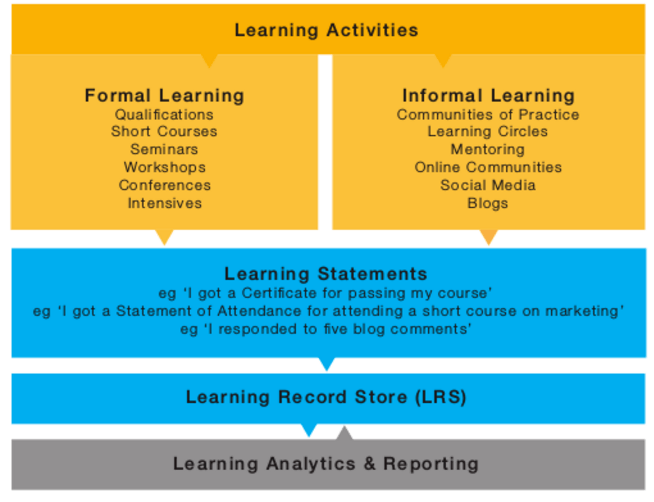Why Your Workplace Needs Social And Collaborative Learning Technologies
The concept of learning through being social at work usually doesn’t conjure up images of high productivity and happy employers. Add social media into the mix and the picture seems even more bleak and at odds with many corporate cultures. But we’ve always engaged in social and collaborative learning in the workplace. Now, we have the technology and the tools to make that process not only increase productivity, but also save time and empower employees with access to shared ideas and collaborative learning processes.
The ATD study 'Building a Culture of Learning' recently reported that top companies are almost five times more likely than lower performers to have extensive learning cultures.
According to the report, “In high-performance organizations, employees share knowledge with their colleagues at a rate four times greater than that of workers in lower-performing firms. That communication is supported by rewarding workers for learning, providing tools and resources for creating and sharing learning content, and making knowledge sharing a performance expectation at all organizational levels.”
(Grissom, How to Make the Case for a Social LMS)
So here are the top 4 reasons that your workplace needs social and collaborative learning technologies:
1. Employees Can Collaborate And Communicate From A Variety Of Geographical Locations And Time Zones Using Enterprise Social Networks
Many companies have shifted from the old style, cubicle-filled office, 9-5 workday systems of industrialized workplaces. A paradigm shift has occurred with flexible working conditions, global teams, and overlapping time schedules.
Introducing an enterprise social network into your workplace enables teams to work on projects at multiple locations, share multimedia content, work simultaneously on the same document, communicate instantly and propose ideas, all within the virtual framework of a social platform.

Image:Designed by Freepik
2. You Can Have A Central Repository Of Information And Learning Content That Can Be Updated And Accessed From Anywhere At Anytime
The days of searching through filing cabinets or company policy handbooks are all but gone. Not only is this a positive step for the environment, it also saves us time, money, and resources.
In many companies, the need for up-to-date information that can be easily sourced from a laptop, mobile phone, or PC is essential. Social and collaborative learning technologies can ensure that employees are able to access vital information at their fingertips.

Image CC0 Licence
Over the past decade or so, companies have attempted to address this issue with knowledge "silos", accessed and shared through internal intranet structures. This is no longer enough, as the sheer amount of data and information that needs to be accessible and transmitted is just too great. Enter the age of enterprise social networks.
3. Enterprise Social Networks Can Collect A Variety Of Learning Experiences And Store Them In A Learning Repository System
Learning experiences can be both formal and informal, with each having their own merits. One of the key benefits to come out of enterprise social networks and the broader EdTech community is the capacity to collect and capture these experiences to better inform the learner’s immersion in the educational activity.
The experience API or xAPI comes in a variety of flavors -Tin Can API, xAPI, lxHive, all of which have superseded the previous standard for collecting learning experiences- SCORM. Let’s say SCORM has been scorned in favor of more expansive and powerful modalities.
To put this in the context of a working environment, you may want to consider the implications of data and analytics. Sure; you may let your accounts department crunch the numbers and come up with some kind of report. But what about analyzing the way your employees learn, train, engage, communicate and share?
Here’s a great example of how the collection of learning experiences can be collected and stored:

Image: brightcookie
The capturing, storage, and analysis of learning experience data can dramatically improve the way we approach learning and development within the constraints of an enterprise social network. The possibilities are exciting and endless.
4. We Need To Connect People Through The Power Of Communities
Sharing is at the heart of learning. The people we work with are best supported when engaged in a community where profiles, teams, groups, forums, and activity streams can be harnessed through the power of social platform communities.
An enterprise social network has the capacity to create a virtual community for your workplace, where a culture of mentorship, team workflows, and gamification elements such as badges for completion of tasks can engage employees in ways that support both the company and the worker.
Blooma, Kurian, Chua, Goh, and Lien (2013) looked at system features in the context of an online course and suggested that the social dimension of micro-collaborations (i.e., mutual interest and effort to achieve a goal) within a Q&A discussion structure promoted collaborative learning via community building, developing self-identity, and improving relational dynamics, which in turn support learning and improve the cognitive process.
(Kimberly S. Scott,Keeley H. Sorokti,Jeffrey D. Merrell, 2016, Learning “beyond the classroom” within an enterprise social network system)
So, What Does The Future Hold For Social And Collaborative Learning In The Workplace?
We have a lot to learn from the variety of social and collaborative learning platforms that are available to businesses – and we have a long way to go until we truly harness the power of these dynamic tools of transformative workplace learning.
But in the long run, we want people to feel connected, informed, and supported in the workplace. And that’s exactly what social and collaborative learning technologies can do through enterprise social networks.








